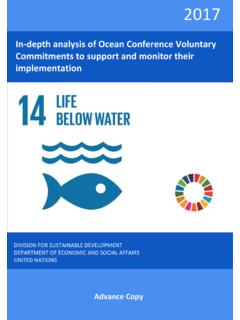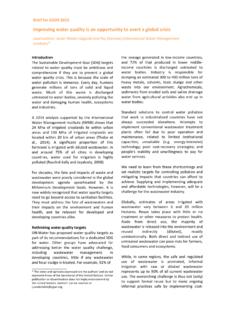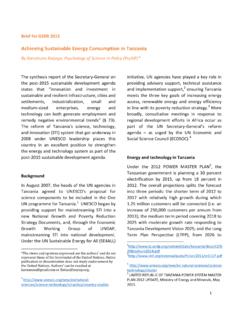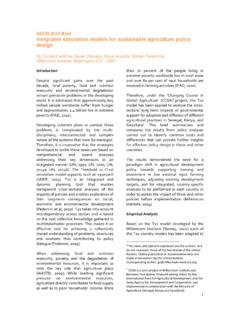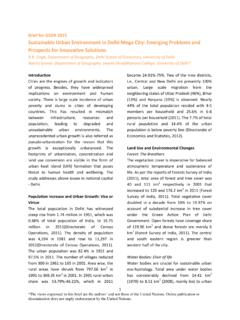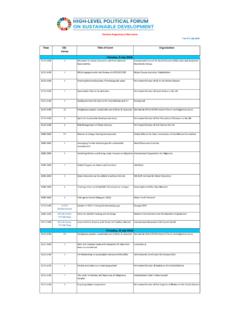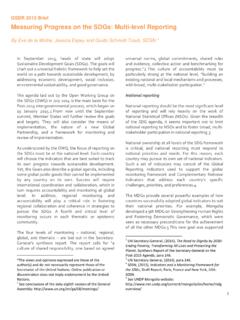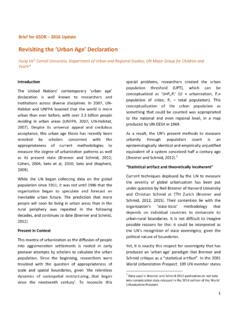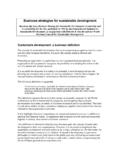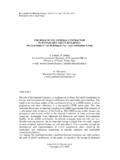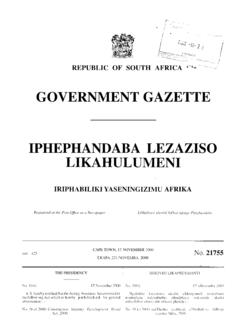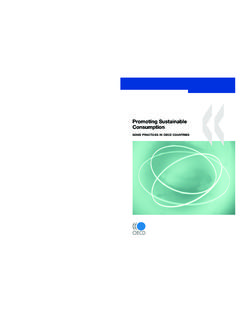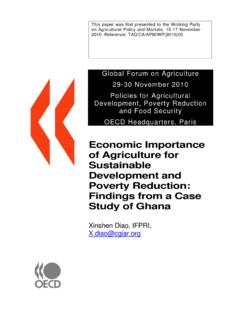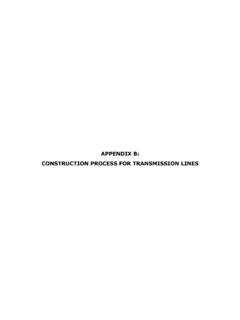Transcription of 75-McCartney-Sustainable development and …
1 Introduction The key to sustainable development is achieving a balance between the exploitation of natural resources for socio-economic development , and conserving ecosystem services that are critical to everyone s wellbeing and livelihoods (Falkenmark et al., 2007). There is no blueprint for obtaining this balance. However, an understanding of how ecosystem services contribute to livelihoods, and who benefits and who loses from changes arising from development interventions, is essential. The sustainable development Goals (SDGs) proposed for water and sanitation (SDG 6) and ecosystems (SDG 15) have targets for restoring and maintaining ecosystems to provide water-related services.
2 The targets mention the need to integrate ecosystem values into planning, development processes, and strategies for reducing poverty. Ecosystem services are the benefits people get from nature. Tangible benefits include supplies of food and freshwater, flood mitigation and improvements to water quality. Less tangible benefits include contributions to cultures. Ecosystems often provide bundles of inter-linked benefits. The way in which this occurs is complex and specific to the type of ecosystem. Many ecosystem services depend on water and are affected by changes in water flows. Although it is difficult to put a monetary value on an ecosystem service, economists are increasingly demonstrating the value of different services (Russi et al.)
3 , 2013). In 2005, the Millennium Ecosystem Assessment found _____ * The views and opinions expressed are the authors and do not represent those of the Secretariat of the United Nations. Online publication or dissemination does not imply endorsement by the United Nations. Authors can be reached at that 70% of the billion people surviving on less than USD 1 per day depended directly on natural ecosystems. Most of these people, especially rural inhabitants, are underserved by government institutions. This situation intensifies their dependence on nature for basic needs (MEA, 2005). Nature also contributes to the resilience of communities. It can reduce the risk of natural hazards and mitigate adverse impacts by, for example, supplying food and water following a disaster.
4 The cost of degraded ecosystems Many ecosystem services are perceived as public goods , accruing outside monetary systems. Until recently, many went unrecognized in planning processes and they continue to be under-valued. Consequently, ecosystems are being degraded at an increasing rate. Infrastructure built primarily to provide people with water for irrigation and domestic, commercial and industrial purposes is crucial for economic growth, for alleviating poverty and for attaining many of the proposed SDGs. However, this infrastructure especially dams has impacts on aquatic ecosystems and, by altering flows of water, sediment and nutrients, can weaken the ecosystem services on which poor communities depend.
5 Modifying ecosystems to facilitate socio-economic development is necessary but how can we avoid damaging important ecosystem services? As a prerequisite, we need to understand how ecosystem services contribute to people s livelihoods and wellbeing. In considering ecosystem services, the intent is to identify interventions that offer people possibilities and improve their livelihoods over the long term. Brief for GSDR 2015 sustainable development and ecosystem services Lead authors: Matthew McCartney, (International Water Management Institute [IWMI]), Max Finlayson (Institute for Land, Water and Society, Charles Sturt University) and Sanjiv de Silva (IWMI) With contributions from: Priyanie Amerasinghe and Vladimir Smakhtin (IWMI)* An example of how this can be achieved comes from southern Africa.
6 Water from seasonal wetlands or dambos is an important resource for farmers here. Many dambos contain small gardens, growing maize, rice and vegetables. These crops are important during times of drought, when rainfall is scarce. Although increasingly under threat, as populations rise and upland farms are degraded, some dambos have been cultivated for many decades. Variations in soil properties make dambos difficult to use for large-scale agriculture. Yet, at a small scale, farmers can use different parts of a dambo in different sustainable ways, reducing the risks of crop failure. Taking an ecosystem approach There is no blueprint for finding the balance between conservation and development but it is essential we understand who will benefit and who will lose out if ecosystem services change.
7 The Millennium Ecosystem Assessment found that cross-sectoral and ecosystem-based approaches to wetland management such as river (or lake or aquifer) basin-scale management, and integrated coastal zone management that consider trade-offs between different wetland ecosystem services are more likely to ensure sustainable development than many existing sectoral approaches and are critical in designing actions in support of the Millennium development Goals (MEA, 2005). This finding remains relevant for designing the SDGs. By focusing more on ecosystem services, land-use planners can determine the values people place on different parts of the landscape in which they live.
8 Currently, these values tend to go unrecognized by wider society, and land-use change for development often results in consequences for the poor that are not adequately compensated. Developing wetlands sustainably The Working Wetland Potential (WWP) concept is an example of an ecosystem approach to development . WWP is a pragmatic approach for considering agriculture in the context of sustainable wetland development . It can be used to identify, organize and analyze the complex factors that link people, agriculture and wetlands. The approach seeks to add value to the benefits ( , ecosystem services) that the wetland provides, without undermining its biophysical or socio-economic sustainability; that is, it supports the wise-use of the wetland, for agriculture, while preserving the essential elements of its ecology.
9 The potential of development activities are considered in relation to the long-term use of the wetland. The WWP approach is based on a multi-criteria analysis that integrates the biophysical and socio-economic aspects of wetland use in a single index to provide an initial assessment of the suitability of a wetland for agriculture (Figure 1). Figure 1: The working potential of Swaziland s Ntfonjeni wetlands. Source: McCartney et. al., 2005 New thinking is also needed in the construction of water infrastructure. We must recognize that the benefits accruing from water infrastructure are dependent on ecosystem services. For example, the performance of a dam will be affected by the flow-regulating services in its catchment.
10 Ecosystem services are integral to the functioning of water infrastructure. Although their effectiveness has been questioned, schemes in which local communities are paid to safeguard important ecosystem services are increasingly being promoted. Ecosystems as natural infrastructure Another approach is to consider ecosystems as natural infrastructure and, taking this concept further, consider how we can design, plan and manage portfolios of natural and built infrastructure in a way that maximizes the full suite of benefits (IUCN, 2014). For example, we should consider reservoirs not simply as inert bodies of water but as ecosystems that can provide water for food, energy and, importantly, other ecosystem services.


